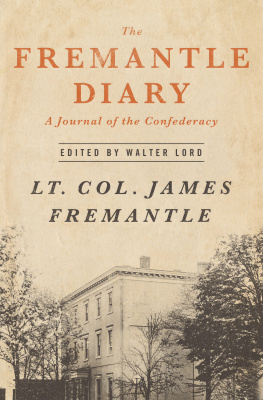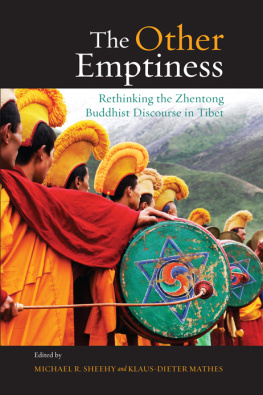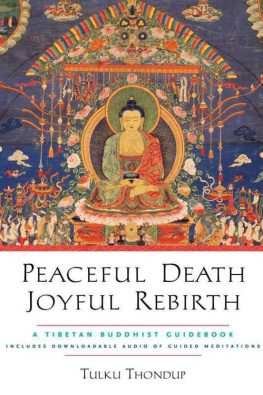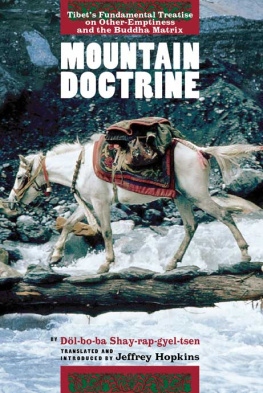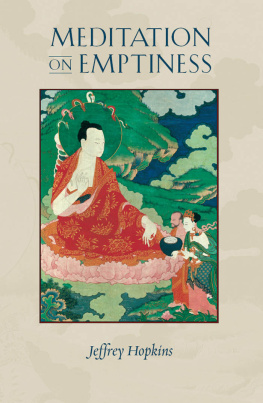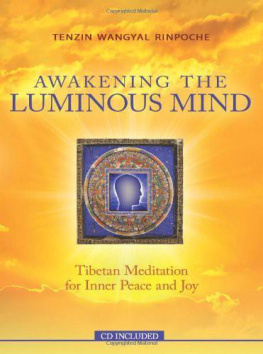Francesca Fremantle - Luminous Emptiness: Understanding the Tibetan Book of the Dead
Here you can read online Francesca Fremantle - Luminous Emptiness: Understanding the Tibetan Book of the Dead full text of the book (entire story) in english for free. Download pdf and epub, get meaning, cover and reviews about this ebook. year: 2003, publisher: Shambhala Publications, genre: Religion. Description of the work, (preface) as well as reviews are available. Best literature library LitArk.com created for fans of good reading and offers a wide selection of genres:
Romance novel
Science fiction
Adventure
Detective
Science
History
Home and family
Prose
Art
Politics
Computer
Non-fiction
Religion
Business
Children
Humor
Choose a favorite category and find really read worthwhile books. Enjoy immersion in the world of imagination, feel the emotions of the characters or learn something new for yourself, make an fascinating discovery.
- Book:Luminous Emptiness: Understanding the Tibetan Book of the Dead
- Author:
- Publisher:Shambhala Publications
- Genre:
- Year:2003
- Rating:5 / 5
- Favourites:Add to favourites
- Your mark:
- 100
- 1
- 2
- 3
- 4
- 5
Luminous Emptiness: Understanding the Tibetan Book of the Dead: summary, description and annotation
We offer to read an annotation, description, summary or preface (depends on what the author of the book "Luminous Emptiness: Understanding the Tibetan Book of the Dead" wrote himself). If you haven't found the necessary information about the book — write in the comments, we will try to find it.
Luminous Emptiness: Understanding the Tibetan Book of the Dead — read online for free the complete book (whole text) full work
Below is the text of the book, divided by pages. System saving the place of the last page read, allows you to conveniently read the book "Luminous Emptiness: Understanding the Tibetan Book of the Dead" online for free, without having to search again every time where you left off. Put a bookmark, and you can go to the page where you finished reading at any time.
Font size:
Interval:
Bookmark:
A deeply heartfelt guide to spiritual fulfillment through Buddhism, Luminous Emptiness provides interested seekers with a journey through the Tibetan Book of the Dead, and Fremantle is an expert guide.
Los Angeles Times
A scholar in Sanskrit and Tibetan, Fremantle is more than qualified to write this guide; she collaborated with renowned meditation master and scholar Chgyam Trungpa on a well-received translation of the Tibetan Book of the Dead in 1975. Nothing less than a careful explanation of the world and the ideas that surround that text, this new work is an excellent and plainly written manual to the complex mythologies, symbols, philosophies, and doctrines of Tibetan Buddhism. The West could hardly ask for a better primer. Highly recommended.
Library Journal
In Luminous Emptiness, Francesca Fremantle provides a commentary on the Tibetan Book of the Dead that integrates its teachings with both the central topics of the Buddhist canon and with the ongoing experiences of our lives. Her illuminating exposition of the inner meanings and relevance of the texts tantric symbolism reflects many years of study, contemplation and practice. Luminous Emptiness is valuable in making the root text more meaningful and suggestive. It succeeds in enlivening our appreciation of the immense possibilities which we are offered now, moment to moment.
Shambhala Sun
This is the most lucid and comprehensive exposition of the Tibetan Book of the Dead to appear in English. It illuminates the esoteric path and reveals the way to heal lifes miseriesthe projection of our minds.
Tulku Thondup, author of the Healing Power of Mind and Boundless Healing
The Tibetan Book of the Dead, a best-seller for three decades, is one of the most widely read texts of Tibetan Buddhism. Over the years, it has been studied and cherished by Buddhists and non-Buddhists alike. Luminous Emptiness is a detailed guide to this classic work, elucidating its mysterious concepts, terms, and imagery. Fremantle relates the symbolic world of the Tibetan Book of the Dead to the experiences of everyday life, presenting the text not as a scripture for the dying, but as a guide for the living.
According to the Buddhist view, nothing is permanent or fixed. The entire world of our experience is constantly appearing and disappearing at every moment. Using vivid and dramatic imagery, the Tibetan Book of the Dead presents the notion that most of us are living in a dream that will continue from lifetime to lifetime until we truly awaken by becoming enlightened. Here, Fremantle, who worked closely with Chgyam Trungpa on the 1975 translation of the Tibetan Book of the Dead (Shambhala), brings the expertise of a lifetime of study to rendering this intriguing classic more accessible and meaningful to the living.
Luminous Emptiness features in-depth explanations of:
- The Tibetan Buddhist notions of death and rebirth
- The meaning of the five energies and the five elements in Tibetan Buddhism
- The mental and physical experience of dying, according to the Tibetan Buddhist tradition
FRANCESCA FREMANTLE received her doctorate from the School of Oriental and African Studies at London University. She is a scholar and translator of Sanskrit and Tibetan works and was a student of Chgyam Trungpa for many years.
Sign up to learn more about our books and receive special offers from Shambhala Publications.

Or visit us online to sign up at shambhala.com/eshambhala.
LUMINOUS EMPTINESS
Understanding the
Tibetan Book of the Dead
Francesca Fremantle

SHAMBHALA
Boston & London
2013
Shambhala Publications, Inc.
Horticultural Hall
300 Massachusetts Avenue
Boston, Massachusetts 02115
www.shambhala.com
2001 by Francesca Fremantle
All rights reserved. No part of this book may be reproduced in any form or by any means, electronic or mechanical, including photocopying, recording, or by any information storage and retrieval system, without permission in writing from the publisher.
The Library of Congress catalogues the hardcover edition of this book as follows:
Fremantle, Francesca.
Luminous emptiness : understanding the Tibetan book of the dead / by Francesca Fremantle.
p. cm.
eISBN 978-0-8348-2478-2
ISBN 978-1-57062-450-6 (cloth)
ISBN 978-1-57062-925-9 (pbk.)
1. Karma-gli-pa, 14th cent. Bar do thos grol. 2. Intermediate stateBuddhism. 3. DeathReligious aspectsBuddhism. 4. Funeral rites and ceremonies, Buddhist. I. Karma-gli-pa, 14th cent. Bar do thos grol. II. Title.
BQ4490 .K3713 2001
294.3423dc21 2001040094
This book is dedicated
to the memory of
the Vidyadhara, Chgyam Trungpa Rinpoche,
incomparable messenger of dharma
and to
Rigdzin Shikpo (Michael Hookham)
who continues his tradition
Contents
Understanding little of my gurus teaching,
Even that little not put into practice,
How can I write as though it has entered my heart,
Like a dewdrop dreaming it can hold the sun?
Please grant your blessing so that beings such as I
May drink the nectar of the Ocean of Dharma.
THE TRUE FOUNT OF INSPIRATION behind the writing of this book is Chgyam Trungpa Rinpoche. It was he who introduced me to the Tibetan Book of the Dead and established my lifelong connection with it by asking me to translate it with him. It is he who is the source of whatever understanding I may have of it. To my deep regret, I was unable to fulfill his expectations and intentions for me while he was alive. This book is my offering to him. With it, I hope to share some of the riches I received from him and carry out at least a small part of his wishes.
Trungpa Rinpoche was probably born in 1940 and was recognized at an early age as a reincarnation in the lineage of the Trungpa Tulkus. He was the eleventh in a line of highly realized teachers, and abbot of the Surmang group of monasteries in eastern Tibet. Tulku means emanation body, which we usually call an incarnation; Trungpa is the name of his lineage, meaning literally one who is in the presence; Chgyam is an abbreviation of one of the many names he received during his training, meaning Ocean of Dharma; and Rinpoche is a title meaning precious jewel, generally used for all respected teachers.
Following the invasion of Tibet by China, he escaped to India in 1959 and came to England in 1963. While living in Oxford, he began teaching a few students, and then moved to Scotland where he founded Samye Ling, the first Tibetan Buddhist center in the United Kingdom. In 1970, he was invited to North America, where his teaching attracted a tremendous response. The United States and Canada remained the bases of his teaching activities until his death in 1987.
The Trungpa lineage belongs to the Kagy school of Tibetan Buddhism, but many of Rinpoches teachers were from the Nyingma school. In his own life and teaching, he combined the characteristic qualities of both traditions. However, for practical purposes, there are significant differences between the methods of the two schools. With his first students in England, he taught primarily from the Nyingma perspective, but after his move to America, he emphasized the Kagy style of practice. In later years, he developed his own unique presentation, known as the Shambhala teachings, whose basic principles he discovered as mind treasures ( gongter ). The Shambhala teachings are drawn from ancient Tibetan and other Asian wisdom traditions, as well as Buddhism; they bring the sacred vision of the tantras into everyday life without the need for any religious affiliation or the use of specifically Buddhist terminology. Thus, three great rivers of his inspiration and blessings have flowed out to the world from the Ocean of Dharma.
Next pageFont size:
Interval:
Bookmark:
Similar books «Luminous Emptiness: Understanding the Tibetan Book of the Dead»
Look at similar books to Luminous Emptiness: Understanding the Tibetan Book of the Dead. We have selected literature similar in name and meaning in the hope of providing readers with more options to find new, interesting, not yet read works.
Discussion, reviews of the book Luminous Emptiness: Understanding the Tibetan Book of the Dead and just readers' own opinions. Leave your comments, write what you think about the work, its meaning or the main characters. Specify what exactly you liked and what you didn't like, and why you think so.


